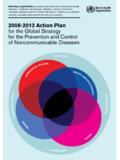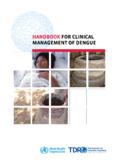Transcription of Global surveillance, prevention and control of - who.int
1 Global surveillance, prevention and control of chronic . respiratory . DISEASES. A comprehensive approach WHO Library Cataloguing-in-Publication Data: Global surveillance, prevention and control of chronic respiratory diseases : a comprehensive approach / Jean Bousquet and Nikolai Khaltaev editors. tract diseases - epidemiology. 2 respiratory tract diseases - etiology. disease , chronic obstructive - epidemiology. 4. Pulmonary disease , chronic obstructive - etiology factors. disease - prevention and control planning. policy. Health Organization. , Jean. , Nikolai. : A world where all people breathe freely. ISBN 978 92 4 156346 8 (NLM classi cation: WF 140). World Health Organization 2007. All rights reserved. Publications of the World Health Organization can be obtained from WHO Press, World Health Organization, 20. Avenue Appia, 1211 Geneva 27, Switzerland (tel.: +41 22 791 3264; fax: +41 22 791 4857; e-mail: Requests for permission to reproduce or translate WHO publications whether for sale or for noncommercial distribution should be addressed to WHO Press, at the above address (fax: +41 22 791 4806; e-mail: The designations employed and the presentation of the material in this publication do not imply the expression of any opinion whatsoever on the part of the World Health Organization concerning the legal status of any country, territory, city or area or of its authorities, or concerning the delimitation of its frontiers or boundaries.))
2 Dotted lines on maps represent approximate border lines for which there may not yet be full agreement. The mention of speci c companies or of certain manufacturers' products does not imply that they are endorsed or recommended by the World Health Organization in preference to others of a similar nature that are not mentioned. Errors and omissions excepted, the names of proprietary products are distinguished by initial capital letters. All reasonable precautions have been taken by the World Health Organization to verify the information contained in this publication. However, the published material is being distributed without warranty of any kind, either expressed or implied. The responsibility for the interpretation and use of the material lies with the reader. In no event shall the World Health Organization be liable for damages arising from its use. The named authors alone are responsible for the views expressed in this publication.
3 Printed in Switzerland This publication was produced under the overall direction of Jean Bousquet and Nikolai Khaltaev (Editors). The core contributors were Alvaro A. Cruz, Eva Mantzouranis (2003-2006), Paolo M. Matricardi (2002-2005) and Elisabetta Minelli (World Health Organization); Nadia A t-Khaled, Eric D. Bateman, Carlos Baena-Cagnani, Michael Boland, Sonia A. Buist, G. Walter Canonica, Kai-Hakon Carlsen, Ronald Dahl, Leonardo M. Fabbri, Yoshinosuke Fukuchi, Lawrence Grouse, Marc Humbert, Claude Lenfant, Jean Luc Malo, Walter T. McNicholas, Ruby Pawankar, Klaus F. Rabe, F. Estelle R. Simons, Archie Turnbull, Erkka Valovirta, Paul van Cauwenberge, Giovanni Viegi, Chris Van Weel, Sally Wenzel and Nanshan Zhong. Valuable inputs in the form of contributions, peer-review, suggestions and criticisms were received from Tim Armstrong, Michal Krzyzanowski, Doris Ma Fat, Salah-Eddine Ottmani, Annette Pruess-Ustun, Eva Rehfuess, Luminita Sanda and Kenji Shibuya (World Health Organization); Ali Ben Kheder, Paulo Camargos, Yu Zhi Chen, Alexander Chuchalin, Peter M.
4 Calverley, Adnan Custovic, Habib Douagui, Wytske J. Fokkens, Amiran Gamkrelidze, Tari Haahtela, Suzanne Hurd, Abai Kabatayevich Baigenzhin, You-Young Kim, Ali Kocabas, Carlos Luna, Fernando D. Martinez, Sylvia Mavale-Manuel, M rio Moraes de Almeida, Paul O'Byrne, Solange Ouedraogo, James P. Kiley, Rogelio Perez-Padilla, Todor Popov, Jose Rosado-Pinto, Kazimierz Roszkowski-Pliz, Alkis Togias, Arzu Yorgancioglu, Mahamad Yousser and Osman Yusuf. Editorial revision was done by Angela Haden and Pieter Desloovere. Book: design and layout, Zando F. Escultura; cover: design and layout, Reda Sadki; pictures: Marko Kokic (cover), Patrick Szymshek (Pel ). and George Herringshaw (Rosa Mota). Report development and production were coordinated by Pieter Desloovere who also was responsible for the web site version. The Global Alliance against chronic respiratory Diseases wishes to thank the following for their generous nancial support: GlaxoSmithKline, Nycomed-Altana Pharma US, Inc.
5 , Chiesi Farmaceutici , Merck & Co. Inc, P zer Inc., Schering Plough Corporation, Astra Zeneca R&D. Lund, Boehringer-Ingelheim Int. GmbH, Novartis Pharma AG, Sano -Aventis and Stallerg nes SA. ii CONTENT. CONTENTS. FOREWORD VII. Dr Catherine Le Gal s-Camus, WHO Assistant Director-General, Noncommunicable Diseases and Mental Health vii SUPPORTING STATEMENTS VIII. Abdul Kalam, Past-President of the Republic of India viii Rosa Mota, Marathon runner and Olympic marathon champion, Portugal ix Edson Arantes do Nascimento, Pel , Football legend, Brazil ix OVERVIEW 1. 1. The Burden of chronic Diseases 1. 2. Preventable chronic respiratory Diseases: A Major Global Health Problem 5. 3. A Mechanism for Action: The Global Alliance Against chronic respiratory Diseases (GARD) 10. chronic respiratory DISEASES 12. 4. chronic disease Epidemics 12. 5. Asthma 15. 6. chronic Obstructive Pulmonary disease 21. 7. Obstructive Sleep Apnea Syndrome 32.
6 8. Pulmonary Hypertension 35. RISK FACTORS FOR chronic respiratory DISEASES 37. 9. Causes and Consequences of chronic respiratory Diseases 37. 10. Tobacco Smoking: The Major Threat in High Income Countries, As Well As in Low And Middle Income Countries 41. 11. Indoor Air Pollutants: The Unrecognized Killers In Low and Middle Income Countries 46. 12. Outdoor Air Pollutants 47. 13. Allergens 49. 14. Occupational Exposure 51. 15. Diet and Nutrition 53. 16. Post-infectious chronic respiratory Diseases 55. STEPWISE FRAMEWORK FOR ACTION 56. 17. GARD Approach 56 iii 18. Estimate Burden, Identify Risk Factors and Undertake Surveillance 61. 19. Advocate for Action 65. 20. Implement prevention and Health Promotion 69. 21. Improve Diagnosis of chronic respiratory Diseases and respiratory Allergies 77. 22. control chronic respiratory Diseases and Allergies by Increasing Drug Accessibility 82. 23. Paediatric chronic respiratory Diseases and respiratory Allergies 95.
7 24. Identify Policy Implementation Steps 98. REFERENCES 102. ANNEX 129. 1. Directory of GARD Participants 129. iv FOREWORD. FOREWORD. chronic respiratory diseases, such as asthma and chronic obstructive pulmonary disease , kill more than four million people every year and affect hundreds of millions more. These diseases erode the health and well-being of the patients and have a negative impact on families and societies. Women and children are particularly vulnerable, especially those in low and middle income countries, where they are exposed on a daily basis to indoor air pollution from solid fuels for cooking and heating. In high income countries, tobacco is the most important risk factor for chronic respiratory diseases, and in some of these countries, tobacco use among women and young people is still increasing. WHO recently launched the Global Alliance against chronic respiratory Diseases (GARD). Spearheaded by WHO, GARD brings together the combined knowledge of national and international organizations, institutions and agencies to improve the lives of millions of people affected by chronic respiratory diseases.
8 Global Surveillance, prevention and control of chronic respiratory diseases: a comprehensive approach raises awareness of the huge impact of chronic respiratory diseases worldwide, and highlights the risk factors as well as ways to prevent and treat these diseases. I hope that this publication will serve not only as a source of information, but also as inspiration to those who want to join the battle against chronic respiratory diseases. By addressing this Global epidemic, much suffering can be avoided and millions of lives can be saved. Dr Catherine Le Gal s-Camus WHO Assistant Director-General, Noncommunicable Diseases and Mental Health v SUPPORTING. STATEMENTS. Better surveillance to map the magnitude of chronic respiratory diseases with reference to needy persons and the disadvantaged is required. chronic respiratory diseases which are preventable, especially affect the elderly and children. Global surveillance, prevention and control of chronic respiratory diseases: a comprehensive approach should be a practical guide on the good principles which can be followed by patients and the public at large.
9 I extend my greetings and felicitations to all those associated with this mission and wish the Global Alliance against chronic respiratory Diseases all success. Abdul Kalam Past-President of the Republic of India vi SUPPORTING STATEMENTS. Reaching a major goal like conquering chronic respiratory diseases is similar to a marathon run: it's a big effort but with energy, knowledge, support and the will to win, it can be done. I am convinced that the Global Alliance against chronic respiratory Diseases will win the battle against chronic respiratory disease , which kills four million people a year. Rosa Mota Marathon runner and Olympic marathon champion, Portugal I am happy to hear that the Global Alliance against chronic respiratory Diseases is now in place as a Global team. As a team, each member will contribute his or her unique strengths, just like in football. Together, the Alliance's teamwork will provide help to the hundreds of millions of people who suffer from chronic respiratory diseases, including those in my country who do not have access to essential treatments.
10 Edson Arantes do Nascimento, Pel . Football legend, Brazil vii OVERVIEW. 1. The Burden of chronic Diseases KEY MESSAGES. 80% of chronic disease deaths occur in low and middle income countries. The threat is growing the number of people, families and communities af icted is increasing. This growing threat is an under-appreciated cause of poverty and retards the economic development of many countries. The chronic disease threat can be overcome using existing knowledge. The solutions are effective and highly cost effective. Comprehensive and integrated action at country level, led by governments, is the means to achieve success. chronic diseases are the major cause of premature adult deaths in all regions of the world. Yet they have generally been neglected on the international health and development agenda. The Global report on chronic diseases from the World Health Organization (WHO) presents current data on the burden of disease , and makes the case for increased and urgent action to prevent and control chronic diseases (1, 2).













